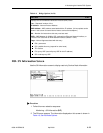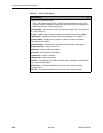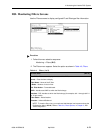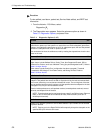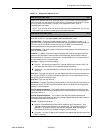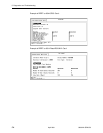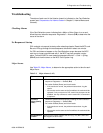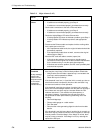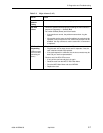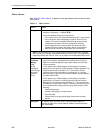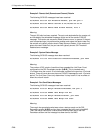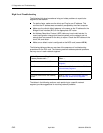
5. Diagnostics and Troubleshooting
8000-A2-GB26-50 April 2001
5-5
Troubleshooting
The status of each card in the Hotwire chassis is indicated on the Card Selection
screen (see
Components of a Hotwire Screen
in Chapter 2,
Hotwire Menus and
Screens).
Checking Alarms
If the Card Selection screen indicates that a Major or Minor Alarm is on a card,
follow the menu selection sequence
Diagnostics
→
Alarms
(
D
-
B
) to determine the
cause of the alarm.
No Response at Startup
DSL cards do not respond at startup after rebooting chassis. Reset the MCC card.
Be sure LEDs go through the reset sequence twice within about one minute.
If a DSL card does not appear on the Card Selection screen because the MCC
card can no longer communicate with it, the MCC card will generate a major
alarm. Follow the MCC’s menu selection sequence
Monitor
→
Card
→
Syslog
(
B-A-C
) and view the event on the MCC Card System Log.
Major Alarms
Use Table 5-2, Major Alarms, to determine the appropriate action to take for each
Major Alarm.
Table 5-2. Major Alarms (1 of 3)
Alarm Action
Selftest Failure
1. Check the Selftest Results display by following the menu selection
sequence:
Diagnostics
→
Selftest
(
D
-
A
)
2. Do another Selftest (Reset) and check results.
– If the results are normal, the problem was transient. Log the
results.
– If the results are the same as the first selftest, the card should be
replaced. If only one port on a DSL card is bad, that port can be
disabled. You may continue to use the card until it is convenient
to replace it.
Processor
Failure (Sanity
Timer)
1. Check the Selftest Results display by following the menu selection
sequence:
Diagnostics
→
Selftest
(
D
-
A
)
2. Do another Selftest (Reset) and check results.
– If the results are normal, the problem was transient. Log the
results.
– If the results are the same as the first selftest, the card should be
replaced.
Non-Supported
Chassis
Check that the chassis supports the card (e.g., only 8610, 8810 and
8820 support the 8312 card).



